Hiba Shehada / Saleh Malas
Hundreds of people struggled to catch their breath; their screams broke through the night, and the terror was replaced by the deadly silence of summer. Doctor Salim Nammour, who lived during the chemical massacre in Eastern Ghouta, was confused by the scene he described.
By August 2013, the Eastern Ghouta was used to constant shelling, siege, and hunger of its 800,000 inhabitants, but minutes after the shells landed on the night of 21 August, the news of suffocation spread.
It was not the first time that the Syrians heard the news of the use of chemical weapons by the Syrian regime against the opposition-controlled areas, and the procedures of dealing with it were immediately present in the mind of the Director of al-Kahf (the Cave) hospital, Doctor Salim Nammour, who rushed with the rest of the medical personnel to the rescue people, he told Enab Baladi.
Treating a vein, giving “Intropin” and oxygen, and using breathing machines are a general culture learned by paramedics and doctors who were rushing while trying to catch up with the injured. The crowds of residents tried to save their families and neighbors as much as they could for three days, during which Ghouta turned into a sleepless beehive.
However, the sounds of pain and death and the suffocating grip of “Sarin” that tightened the soul of those who strived to rescue without protective clothing did not make the doctors forget to take samples from the injured, including blood, hair, urine, and clothes, and save them for “documenting the crime and preserving rights.”
What are the consequences of this documentation? What is the impact of the evidence on the course of justice for victims of chemical weapons attacks in Syria?
In this file, Enab Baladi discusses these questions and meets with witnesses, activists, experts, and human rights defenders in an attempt to obtain answers to them.
Memories that never vanish with time
Whom should we save first?
Mohammad Humaidan was a member of the “Zamalka Coordination Team” and a correspondent for Al Aan TV, in August 2013. He witnessed the massacre and tried to document it, but he went to the relief and emergency branch, which was more necessary, as he described to Enab Baladi.
Humaidan was surprised by the sound of the shells that fell that night while he was going back home, at 01:45. It was not the sound of a loud explosion, but a deep sound, “like the explosion of a balloon filled with water,” as he described it.
Minutes from reaching the medical point, holding his camera, he was surprised by the number of injured people, who were transferred by the railing cars to the hospital. At the same time, the rescuers would receive them with quick rescue attempts.
Humaidan left the camera and went to assist, taking advantage of his knowledge of emergency measures, injecting needles and washing the injured, to witness the entry of thousands of injuries and dozens of deaths in the hands of the paramedics, while the regime was continuing its bombardment with mortars and artillery on Zamalka, Ein Tarma and Jobar, and its tanks were trying to storm Jobar, Zamalka, and Irbin.
Humaidan compared those hours to a “microcosmic picture of resurrection day” with the unforgettable tragedies he witnessed. He said: “I remember trying to provide oxygen to a woman in her fifties, who was struggling with death, and her daughter was closer, holding her injured child, who also needed oxygen, and because of the lack of masks, she was in pain (…). I didn’t know if I should leave her mother to give oxygen to her son or leave the son without oxygen and help the mother? The mother died in my hand.”
After three hours of assistance, chemical contamination began to affect Humaidan, who returned home and was trying to control himself, before returning following the increase in the number of dead and injured, until the number of dead in Zamalka alone Humaidan reached 900 victims documented by name.
Humaidan gave his testimony about what happened to several human rights organizations. He heard from the UN Commission of Inquiry saying that days after the attack, “There is no room for doubt about the perpetrator.” However, when the file reached the Security Council, those statements were changed, and the Commission considered that it had insufficient evidence to break the suspicion.
Fast documentation and denial
Hundreds died and were buried in mass graves without evidence after their photos were taken and preserved by activists who documented the names and details, they could obtain about the victims. Meanwhile, the Syrian regime was busy denying the attacks, blaming the victims by the opposition’s kidnapping of men and children from Latakia villages, bringing them to al-Ghouta, and using chemical weapons against them. This is the story by which Buthaina Shaaban, presidential palace advisor, surprised the world a few days after the attack.
Sixteen surface-to-surface missiles targeted the eastern Ghouta towns. Their focus was on Zamalka, Kafr Batna, Irbin, and Ein Tarma, and caused an international shock, for violating the “red line” that the former US President, Barack Obama, had announced on 20 August 2012, threatening by saying: “We have been very clear with al-Assad regime, but to other parties on the ground as well, the red line for us is our observation of the large numbers of chemical weapons being transported and used. This may change my view.”
A week after the attack and with the efforts of activists, human rights defenders and doctors, an international investigation committee entered Ghouta and received the casualty statistics, which amounted to 10,000 injuries and more than 1,530 deaths, according to Dr. Salim Nammour, who accompanied the investigators and provided them with evidence.
However, the UN investigation and the US threat did not lead to any military move against Syria. After 18 days of study and seeking to obtain congressional approval to conduct the strikes, Obama disavowed his previous threats, saying “the world has set a red line when the governments that represent 98% of the world’s population said that the use of chemical weapons is prohibited, and a treaty has been approved prohibiting their use, even when countries are at war.” He announced, on 9 September 2013, the postponement of airstrikes and the renewal of focus on diplomatic solutions.
Five days later, US Secretary of State John Kerry and Russian Foreign Minister Sergey Lavrov agreed to remove and destroy Syria’s chemical weapons arsenal, with the Security Council’s resolution “2118” on 27 September 2013, to oversee the removal of the arsenal in the safest and fastest possible way.
The regime joined the “Chemical Weapons Convention,” which prohibits the use, development, production, stockpiling and transfer of chemical weapons, in October 2013, announcing what it said was its chemical weapons stockpiles, presenting them to the “joint mission of the Organization for the Prohibition of Chemical Weapons and the United Nations.” They supervised the disposal of the arsenal, until the Director of the Organization for the Prohibition of Chemical Weapons announced the implementation of the mission with “success under very complex and difficult circumstances,” on 19 August 2014.
The international moves did not bring that reassurance to the victims and witnesses. Doctor Salim Nammour described the feelings of the survivors as “disappointed” after the handover deal, which was “a disgrace” to the world, indicating that the victims’ right “will not die” and witnesses will not remain silent about the crime.
UN reports on the path of Syrian justice proves the Syrian regime’s involvement, amid international countries’ inaction
Dozens of reports by the Organization for the Prohibition of Chemical Weapons (OPCW) on the use of chemical weapons in Syria have been condemned and denied by the regime and its allies, ignoring evidence.
The Chemical Weapons Convention states that each state party pledges not to develop or produce chemical weapons or possess them in one way or another, store or keep them, or transfer chemical weapons directly or indirectly to anyone, in addition to not using them, or making any military preparations to use them, or assisting, encouraging or urging anyone in any way to carry out activities prohibited for states parties under the agreement.
One of the most critical requirements of the convention was to establish an inspection committee within the technical secretariat of the convention and to grant it the power to investigate allegations on the use of chemical weapons. The Committee shall be regarded as independent and technical. If it finds that a state party to the convention violates its provisions, it has the power to restrict or suspend its rights and privileges under the Convention based on the recommendation of the Executive Council, until the necessary measures are taken to expel it under the provisions of the Convention.
In severe cases, the case, including relevant information and conclusions, must be submitted to the United Nations General Assembly and the United Nations Security Council.
Five committees and 93 reports
Committees of investigation dealing with violations of the Syrian regime have been established on a permanent basis since 2011, five of which were meant to investigate the use of chemical weapons. Since 2013, the Organization for the Prohibition of Chemical Weapons has submitted 71 monitoring reports on its investigations, 22 special reports, and eight decisions on its activities in Syria.
The International Independent Investigation Commission on Syria, launched by the Human Rights Council on 22 August 2011, stated in the article No. 128 of its seventh report released in 2014 that “the commission had access to the Syrian army’s stockpile of chemical weapons,” referring to the chemical attack launched in some towns and villages in the Damascus countryside on 21 August 2013.
On 27 September 2013, the United Nations Security Council published Resolution No. 2118, stating in its Article 21 that it would impose measures according to Chapter VII of the Charter of the United Nations in case the Syrian regime does not comply with this resolution. The parties involved in the conflict in Syria are compelled to stop chemical weapons use under Article V thereof. As for article 15, it stipulates accountability regarding individuals who are responsible for the use of chemical weapons in Syria.
In 2014, after disagreements over the Syrian regime’s declaration of its entire chemical arsenal, the Organization for the OPCW established a The Declaration Assessment Team (DAT), which has made more than 20 visits to Syria, held multiple meetings with Syrian authorities, visited previous sites for the use of chemical weapons and collected samples.
The Team was not in a position to resolve all the gaps, inconsistencies, and disagreements related to the Syrian regime’s declaration. Therefore it did not fully confirm the accuracy of the declaration or its compatibility with the “chemical weapons” treaty, according to its report released in June 2016, while the team’s mandate is still applicable to determine the destruction of the Syrian chemical arsenal.
In its resolution No. 2209 of 2015, the Security Council condemned the use of any toxic chemical, such as chlorine, for weaponization, and underlined the need to hold responsible individuals accountable, and threatened once again to impose Chapter VII measures in case of an escalation in the use of chemical materials as weapons. Fourteen members in the Security Council voted to support the Resolution, including Russia, which is an ally of the Syrian regime, while Venezuela withdrew its vote.
In February 2017, Russia and China used their veto rights to oppose a resolution to impose sanctions on the Syrian regime for the use of chemical weapons. The resolution was approved by nine members, opposed by three countries, Russia, China, and Bolivia, while other countries abstained from voting, including Kazakhstan, Ethiopia, and Egypt.
Evidence of the involvement of the Syrian regime
Based on Security Council Resolution No. 2235, the Joint Investigation Mechanism (JIM) between the United Nations and the “Prohibition of Chemical Weapons” was established on 7 August 2015.
In a report submitted on 26 October 2017, the Syrian regime was held responsible for the use of Sarin gas in the town of Khan Sheikhoun in the Idlib countryside on 4 April 2017, in addition to three chlorine gas attacks committed between 2014 and 2015, which were documented in six previous reports.
The Security Council, using the Russian “veto,” suspended its mandate in November 2017, before the Organization for the Prohibition of Chemical Weapons (OPCW) was able to form the “Investigation and Identification Team” (IIT), which received its mandate from the decisions adopted by the Conference of States Members under the title “Dealing with the threat of the use of chemical weapons,” on 27 June 2018.
The report of the first team was released on 8 April, stating that the Syrian regime is responsible for the use of chemical weapons in the town of al-Lataminah in the northern countryside of Hamah in March 2017. The Security Council condemned the use of chemical weapons and gave a 90-day deadline for the regime to announce full details regarding the plants producing “Sarin” and “Chlorine,” which were used during the 2017 attacks; otherwise, the case will be submitted for consideration at the annual meeting of Member States in November, with “recommendations on further action to be undertaken in case the issue remains unresolved.”
Amid the absence of legal action, what is the point of the documentation?
Several human rights organizations have been working to document events in the Eastern Ghouta, based on eyewitnesses, details of injured, and victims. Despite the “gaps” identified in local human rights documentation at that time, their statements were marked by the “credibility” thanks to reliable information gathered from various sources, said the Director of the Syrian Centre for Statistics and Research, Tariq Bilal, to Enab Baladi.
At that time, activists tried to answer three questions: What happened? Who is the victim? Who is the responsible party? Considering the limited capacity of laboratory tests to confirm the available data, the collected files provided a clear answer about the victim’s identity, gave a clear explanation about “what happened, “and paved the way to know” the perpetrator,” according to Tariq Bilal.
The center has documented dozens of testimonies, in Bilal’s view. If these documents were combined with the testimonies recorded by other local organizations, they would have provided a solid basis for trial documentation, but “accountability involves difficult compromises,” he said, adding that the Syrian regime’s accountability failed to find a public court to deal with the grave violations committed.
The process of documenting and checking testimonies is continuous and permanent, said the Director of the “Syrian Human Rights Network,” Fadl Abdul-Ghani, to Enab Baladi, noting that the verification and investigation process “does not stop,” as documentation is a cumulative work that aims to investigate not to collect.
The Network’s approach is based on the scrutiny of available data on the attacks, such as time, location, weather conditions, number of deaths, victims, type of weapon used, photos and videos captured, as well as the study of weapon remains, if available, samples, and primary sources of the victims’ relatives, doctors and paramedics to gather available information.
Abdel-Ghani believes that relating accountability to the judicial decision seems to be “misunderstood,” as punishment and deterrence of the criminal are more than just imposing political, military and economic sanctions, which he described as “quick” accountability when compared to the long term accountability represented by the judicial process.
He went on to say that the role of the documentation files is not restricted to the judicial process, but instead, it has other aims, such as denying and refuting the regime’s version of the story and that of its allies, and ensuring that it does not distort the history.
While the resolutions aimed at imposing UN sanctions have not yet been able to achieve their goal, the reports of the Joint Commission and the Security Council have encouraged some states to use their domestic laws and impose unilateral sanctions. For example, the US has put 18 officials affiliated to the Syrian regime and related to the chemical weapons program in Syria, on the ban list.
The long road to bring justice is long
In a poll conducted by Enab Baladi on its Facebook page, 78% of the voters, more than 700 people, doubted that the victims would obtain justice from the perpetrators, while the rest believed that this would happen.
Ola Ali commented that “seldom in the history of massacres in the world that the victims obtained their rights or the perpetrators were punished,” while Ahmed Salah justified his objection by saying that “the judge himself is the executioner.”
These stances have resulted from the absence of clear and direct action against the Syrian regime, despite condemning its factions for using chemical weapons.
UN and independent reports demonstrated a series of investigations that examined the situation in cities and towns in which the Syrian regime used chemical weapons, within the legitimate means and jurisdiction through which the committees conduct inquiries.
Director of Syrians for Truth and Justice (STJ), Bassam al-Ahmad, told Enab Baladi that the Independent International Commission of Inquiry on the Syrian Arab Republic has specific jurisdictions, which authorize it to document the events that took place in the cities and towns of Eastern Ghouta, Damascus, and to ensure that the regime used toxic gases, without pressing charges against a particular party of using banned arms. Thus, the mechanism for gathering evidence to accuse any party to the conflict in this regard takes a long time.
The Syrian human rights activist, Mansour al-Omari, attributed the reasons for the aforementioned obstacle while talking to Enab Baladi, to the difficulty of “bringing criminal evidence from one country to another and possibly through several countries, and this stage also requires legal documentation of the evidence journey.”
The collection of testimonies, which may be numerous and taken from persons in different countries, also contributes, according to al-Omari, to prolonging the period of gathering evidence to press charges and prepare for any trial in this regard.
The documentation of evidence proving the Syrian regime’s use of chemical weapons by the UN, and international and Syrian organizations, when presented in any legal context, requires research and scrutiny of their status as legal evidence accepted by the courts in the countries in which any lawsuit against the Syrian regime will be filed.
Speaking to Enab Baladi, the spokesman for the Violations Documentation Center in Syria (VDC), Ahmad al-Ahmad, attributed the reason for the delay in the international investigation process to the obstruction to which its committees were subjected to by the allies of the Syrian regime in the UN Security Council, as the investigation body did not initially have the mandate to determine who is responsible for the chemical attacks in Syria.
The international efforts to distance the mandate of the investigation mechanism from the UN Security Council vote took two years of efforts by some Western countries, as the UK proposed transferring the vote from the Security Council to the Executive Council within the Organization for the Prohibition of Chemical Weapons (OPCW) while expanding its powers.
Attempts to prosecute the Syrian regime
Al-Ahmad explained to Enab Baladi that no trial for the users of the chemical weapon in Syria will take place while the head of the Syrian regime, Bashar al-Assad, is still in office.
Rather, those trials will be within the hierarchy of the individuals responsible for issuing orders in this regard and scrutiny of those accountable who objected to the crime, and the persons who were aware of the occurrence of such use of prohibited weapons.
According to al-Ahmad, Bashar al-Assad can also be tried if the evidence gathered by the organizations leads to establishing a direct link between him and the issuance of orders to use chemical weapons.
It takes a long time for Syrian and international organizations to provide a legal study and to search for countries in which they can file lawsuits in this regard.
According to al-Omari, each country has its own laws and differences regarding universal jurisdiction, which is an important part of the international efforts aimed to hold war criminals accountable in Syria and to provide justice to the victims.
Following the completion of the lawsuit file, these organizations are required to submit it to court, and then the court considers its jurisdiction. Once the court decides to handle the case, the hearing process starts said al-Omari.
Regarding efforts to prosecute the Syrian authorities, al-Ahmad said that the VDC is cooperating with the European Center for Constitutional and Human Rights (ECCHR) and the Syrian Center for Legal Studies in Berlin by communicating with the German Attorney General and European judicial bodies specialized in international war crimes, to file lawsuits against the regime, indicating that the human rights centers are awaiting the European response.
According to al-Ahmad, the VDC signed a memorandum of cooperation with the United Nations’ International, Impartial and Independent Mechanism several weeks ago, to work on building a criminal file in accordance with international criminal standards, enabling prosecutors in any international judicial body to request the file appropriately and directly from the mechanism for building cases against the Syrian regime.
Witnesses defy the regime’s narrative
While entering the medical center in Douma, on 21 August 2013, the thing that caught Hassan Mohammed’s attention was the absence of any smell of blood, even though he heard of a massacre. What he witnessed was far different from anything he saw before, as the injured, screaming of pain, were not bleeding.
Mohammed carried out his mission as a media activist at the time, documenting the injuries and deaths of those who flocked to the medical points in his city from the towns of Ghouta that were affected by the largest chemical massacre during the years of the Syrian war, but the international response that failed to hold the perpetrators accountable did not live up to his hopes.
The activist used the evidence he documented by his camera to testify against the Syrian regime and to participate in campaigns to condemn the violations committed in Eastern Ghouta.
The activist told Enab Baladi that year after year, Syrian activists have joined efforts to launch campaigns and publish testimonies of the incident while commemorating the victims of chemical massacres, the most recent of which is the “Do not repress the truth” campaign that aims to oppose the regime’s denial of committing chemical massacres.
The campaign is launched on the anniversary of the chemical massacre this year, and aims to expose the danger of denial and its consequences for the victims and the course of justice, in addition to confronting the authorities’ attempt to obliterate the truth and tamper with evidence.
During the previous years, the Syrian regime has resorted to disavow responsibility for any chemical attacks, while accusing the opposition factions at times and the White Helmets at other times. Following the settlement agreement signed in Eastern Ghouta in 2018, 12 civilians were presented as eyewitnesses on 26 April of that year at the headquarters of the OPCW, to support the regime’s narrative of not using chemical weapons in Douma, while Western countries considered it a “scandalous farce.”
The nurse and feminist activist, Tuhama Darwish, told Enab Baladi that the Syrian regime has been terrorizing the survivors and witnesses while using intimidating methods such as arresting them or their families in an attempt to cover up the chemical massacres committed in al-Ghouta.
The activist talked about the campaign activities in which she is participating this year, presenting her testimonies about treating the injured and trying to save those who passed away, in order to “convey the truth to the world and expose the brutality and criminality of the regime.”
The campaign will not be limited to one day, as it includes the launch of a website and a YouTube channel to publish documentary content based on the survivors’ testimonies and videos in several languages, with the names of victims of the eastern Ghouta massacre, in addition to distributing leaflets and badges with the campaign slogan on them inspired by the chemical weapon logo.
According to the activist, if this campaign does not make a tangible impact in the near future, then it will serve as a constant reminder which aims at “exposing the regime and its allies, and honoring the memory of the martyrs while demanding a fair trial for the perpetrators until all those who committed crimes against the Syrian people are held accountable.”
if you think the article contain wrong information or you have additional details Send Correction
النسخة العربية من المقال
-
Follow us :












 A UN expert collecting samples to investigate the chemical weapons attack in Eastern Ghouta - 2013 (AFP)
A UN expert collecting samples to investigate the chemical weapons attack in Eastern Ghouta - 2013 (AFP)





 A
A
A
A
A
A

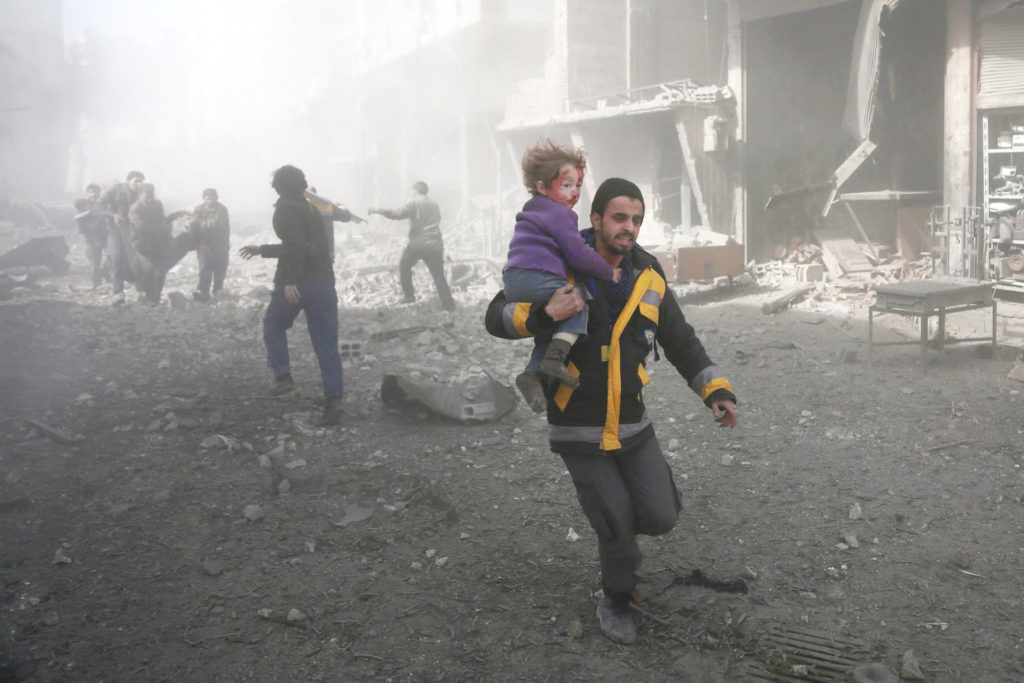
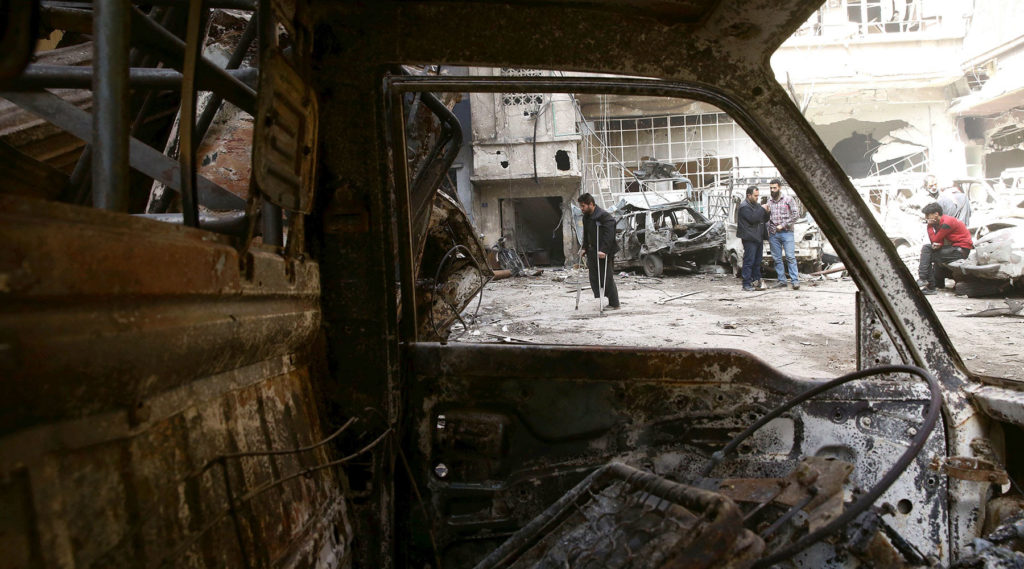
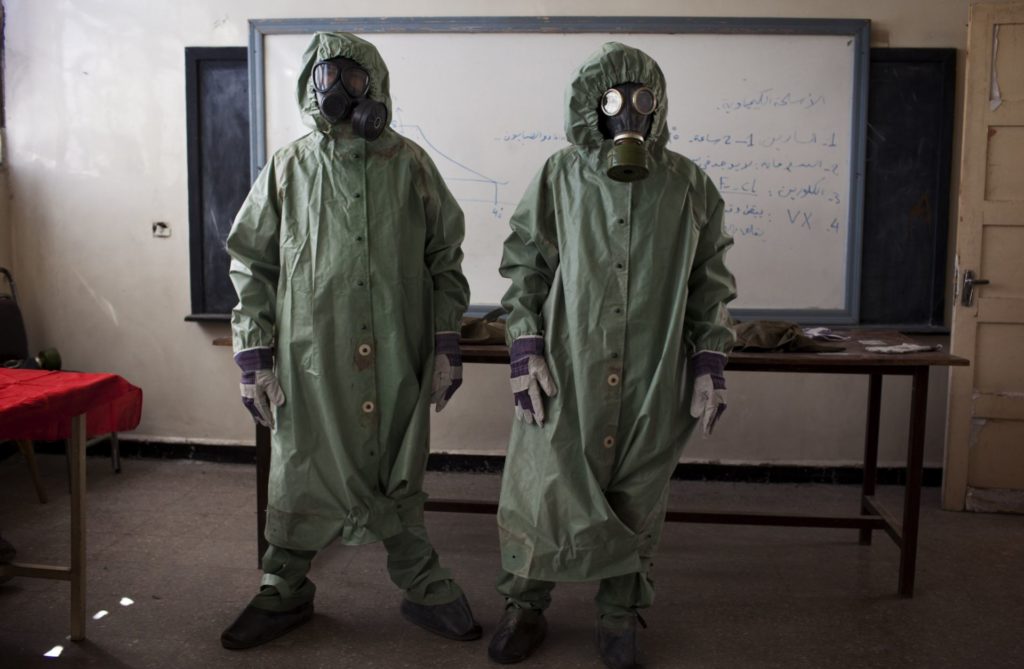
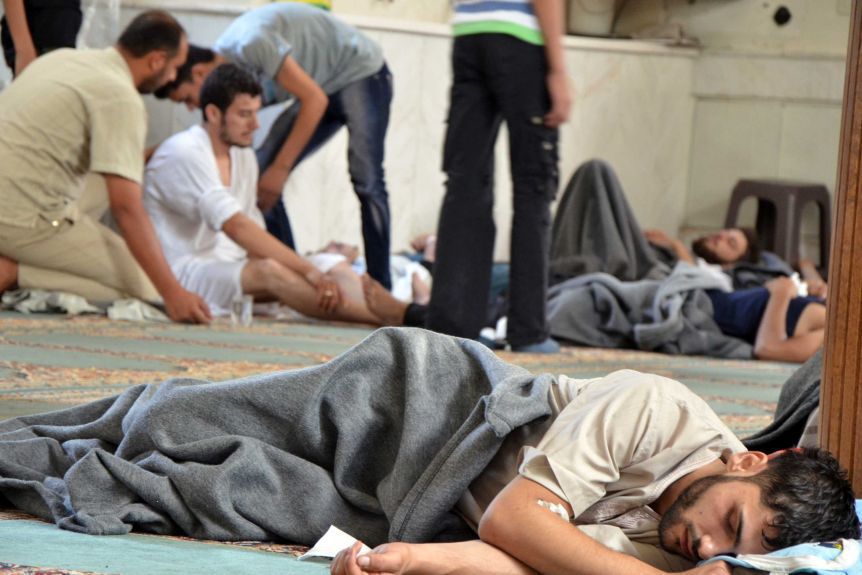
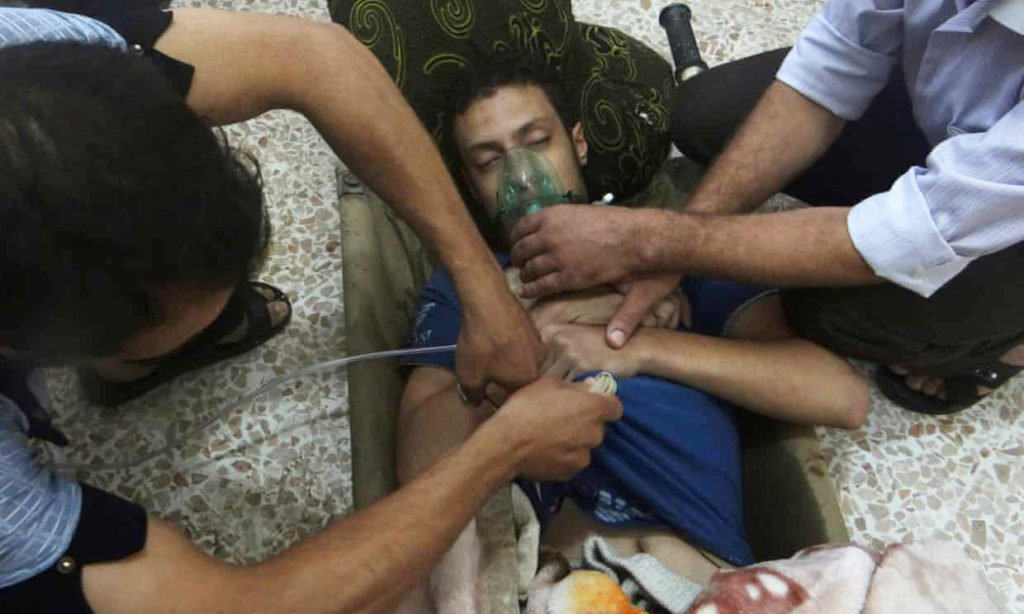
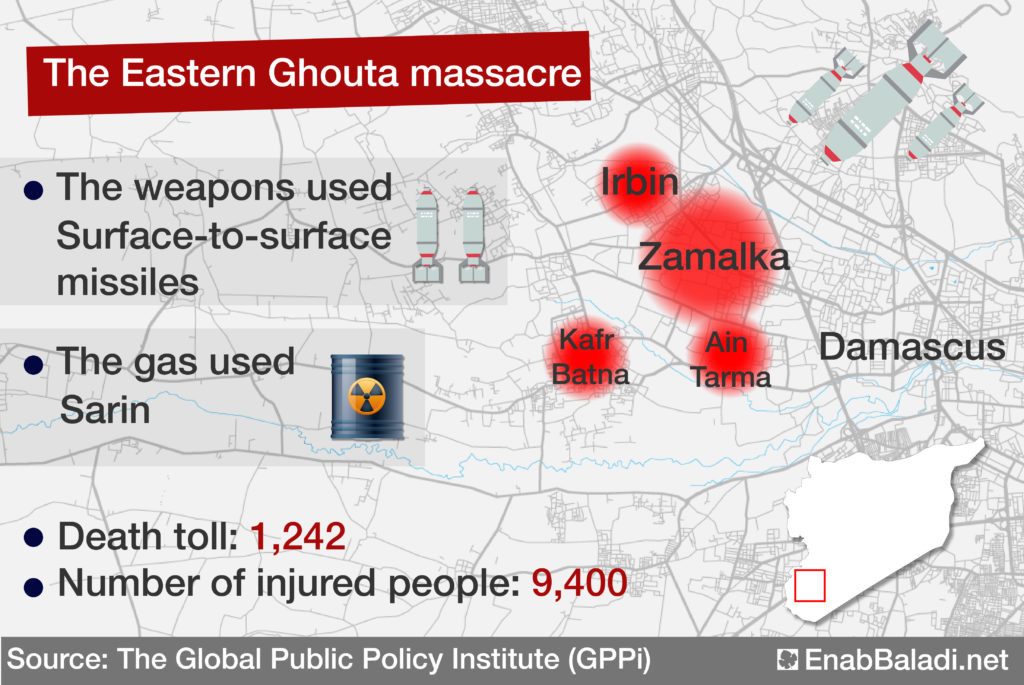


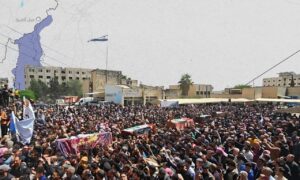



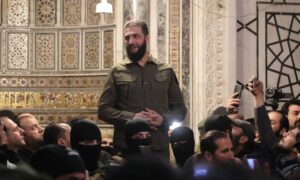
 More In-Depth
More In-Depth